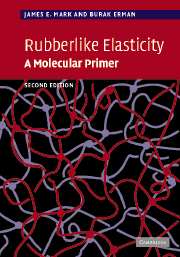Book contents
- Frontmatter
- Contents
- Preface to the first edition
- Preface to the second edition
- Part I Fundamentals
- Part II Additional topics
- 11 Networks prepared under unusual conditions
- 12 Strain-induced crystallization and ultimate properties
- 13 Multimodal networks
- 14 Birefringence and segmental orientation
- 15 Neutron scattering from networks
- 16 Liquid-crystalline elastomers
- 17 Bioelastomers
- 18 Filled elastomers
- 19 Current problems and new directions
- Appendix A Relationships between ν, ξ and Mc
- Appendix B Relationships between 〈r2〉, 〈(Δr)2〉, 〈r2〉0, and ϕ
- Appendix C Equations of state for miscellaneous deformations from the constrained junction theory
- Appendix D Thermodynamics of the relationship of stress to temperature
- Problems
- Answers to problems
- Some publications describing laboratory/classroom experiments or demonstrations
- References
- Index
13 - Multimodal networks
from Part II - Additional topics
Published online by Cambridge University Press: 04 December 2009
- Frontmatter
- Contents
- Preface to the first edition
- Preface to the second edition
- Part I Fundamentals
- Part II Additional topics
- 11 Networks prepared under unusual conditions
- 12 Strain-induced crystallization and ultimate properties
- 13 Multimodal networks
- 14 Birefringence and segmental orientation
- 15 Neutron scattering from networks
- 16 Liquid-crystalline elastomers
- 17 Bioelastomers
- 18 Filled elastomers
- 19 Current problems and new directions
- Appendix A Relationships between ν, ξ and Mc
- Appendix B Relationships between 〈r2〉, 〈(Δr)2〉, 〈r2〉0, and ϕ
- Appendix C Equations of state for miscellaneous deformations from the constrained junction theory
- Appendix D Thermodynamics of the relationship of stress to temperature
- Problems
- Answers to problems
- Some publications describing laboratory/classroom experiments or demonstrations
- References
- Index
Summary
Introduction
The main purpose of this chapter is to illustrate how manipulating the distribution of network chain lengths in an elastomer can give large improvements in its mechanical properties. This approach is very novel in that the effect of network chain-length distribution (Flory, 1953; Treloar, 1975) is one aspect of rubberlike elasticity that has not been studied very much until recently. There are two primary reasons for this lack of attention. On the experimental side, the cross-linking techniques traditionally used to prepare the required network structures have been random, uncontrolled processes (Flory, 1953; Treloar, 1975; Erman and Mark, 1997). The resulting network chain-length distributions are unimodal and probably very broad. On the theoretical side, it has turned out to be convenient, and even necessary, to assume a distribution of chain lengths that is not only unimodal, but monodisperse (Flory, 1953; Treloar, 1975; Erman and Mark, 1997)!
There are a number of reasons for developing techniques for determining or, even better, controlling network chain-length distributions. One is to check the “weakest-link” theory (Bueche, 1962) for elastomer rupture, which states that a typical elastomeric network consists of chains with a broad distribution of lengths, and that the shortest of these chains are the “culprits” in causing rupture. This is attributed to the very limited extensibility associated with their shortness, which is thought to cause these chains to break at relatively small deformations and then act as rupture nuclei.
- Type
- Chapter
- Information
- Rubberlike ElasticityA Molecular Primer, pp. 131 - 148Publisher: Cambridge University PressPrint publication year: 2007



